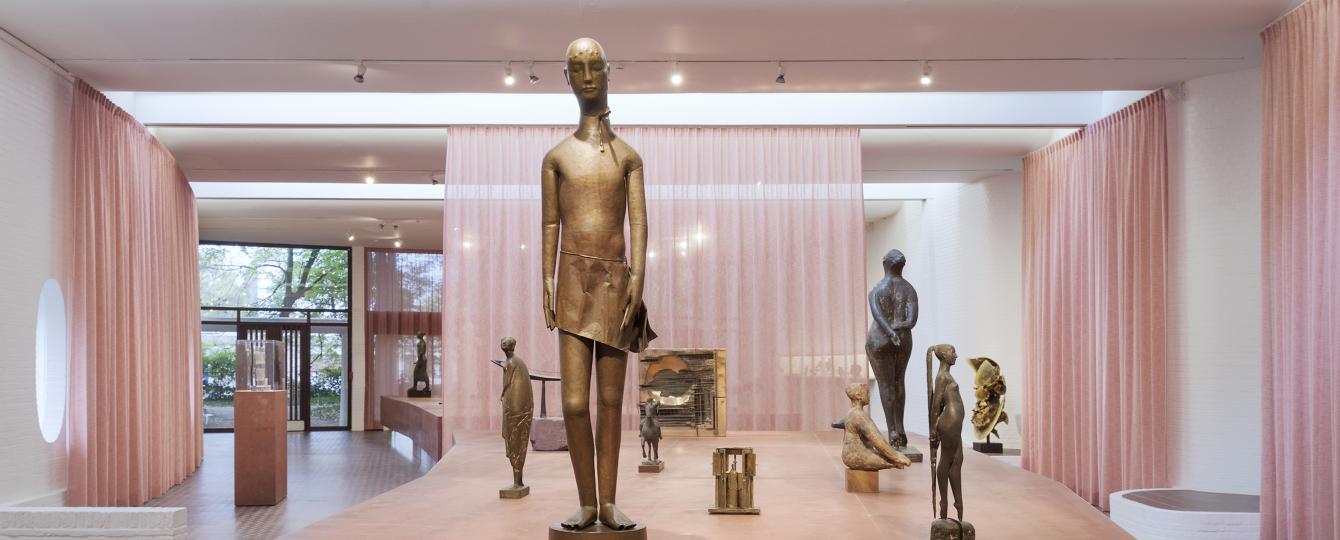Ode to freedom
These 41 table-top sculptures bear witness to the renewed creative and artistic freedom discovered by post-war artists. Figurative, abstract or informal; heavily burdened or light as a feather; within or outside an artistic movement; reacting to society or detached from any referential framework: the small sculptures of RECALL SCULPTURE are also and above all a forerunner of contemporary art.
The works of Pietro Consagra (1920-2005), Arnoldo Pomodoro (born 1926), Francesco Somaini (1926-2005), Elisabeth Schaar (1908-1975), Bernhard Heiliger (1915-1995), Marino Marini (1901-1980) and others are therefore displayed in a perfect setting in the Middelheim. And in a way, they are also coming home for a while.
A place of encounter
On 1 June 1950, the International Exhibition of Sculpture 1900-1950 opened in Antwerp’s Middelheim Park as an initiative of Lode Craeybeckx, Mayor of Antwerp. The idea quickly arose of making the exhibition permanent in the form of an open-air museum for sculpture, the current Middelheim Museum. It was to offer an overview of international contemporary sculpture, also paying attention to the main precursors of the late 19th and early 20th century.
As well as leading to the idea of a permanent collection, the successful exhibition of 1950 in the Middelheim Park also gave rise to a plan for periodic presentations. These ‘international exhibitions of sculpture’, held every two years, became known as the Middelheim Biennials from 1953 onwards. Their purpose was to monitor the pulse of contemporary art. The last Middelheim Biennial took place in 1989.
Cross-pollination
Mayor Lode Craeybeckx was also chairman of the board of directors of the Royal Museum of Fine Arts Antwerp (KMSKA). Together with Walther Vanbeselaere, the KMSKA’s head curator he wanted the KMSKA to expand its collection to include contemporary art, a trend followed by many museums at that time , now that the Second World War was over. In 1950, Craeybeckx and Vanbeselaere visited the Venice Biennale, which proved to be a source of inspiration for both museum collections.
For the KMSKA, the Middelheim Biennials were an equally important source of information and inspiration. At these successive two-yearly events, the KMSKA acquired about forty table-top sculptures. In addition, the museum gave out a number of large sculptures from its own collection on long-term loan to the Middelheim – iconic works such as Rik Wouters’ Het zotte geweld and Auguste Rodin’s Balzac. These masterpieces have remained among the Middelheim Museum’s most important works until the present day.
The museum is hosting the exhibition as part of the Dicht maar dichtbij (Closed but close by) programme of the Royal Museum of Fine Arts Antwerp pending its reopening in 2019. Curator of the exhibition is Greta Van Broeckhoven, conservator of 20th century art, KMSKA.
Practical information
Entry
Free
Opening hours
- October to March: from 10 AM until 5 PM
- Closed on Mondays and 1 November
Visitors text
- Download here
- Free
Introductory film
- In the hall of the Castle
- NL with EN subtitles
For sale in the museum shop
Publication (in Dutch) accompanying the exhibition with texts by curator Greta Van Broeckhoven
- Published by BAI
- 24.50 euro
Guided tours for groups
Info, reservations and payment via Visit Antwerpen
- tel. 03 232 01 03
- tickets@visitantwerpen.be


